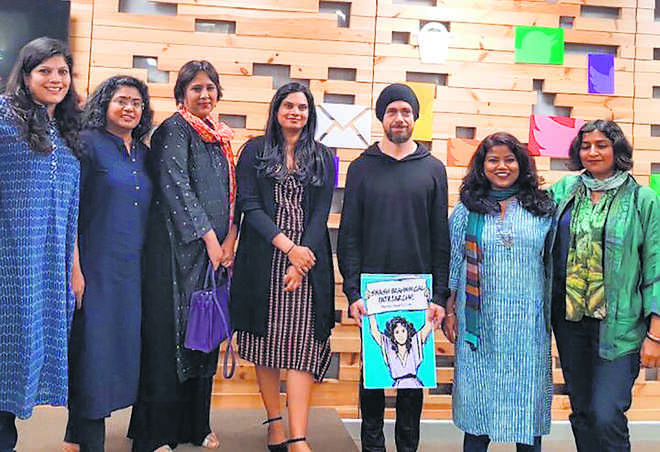
Potemkin moment: Some poster writers are reducing the struggle against inequity to empty sloganeering. photo courtesy: Twitter
Rajesh Ramachandran
THE Brahminical caste pyramid and its oppressive social hierarchy are hard facts of Indian life. On Sundays, the biggest newspaper of every Indian city announces the caste order of the region in its matrimonial columns, and it is a must-read for all students of politics and sociology. Wedding, interestingly, is one happy occasion when modern, progressive, liberal or radical lies get exposed. The louder the liberals are, greater the chances of a gotra-dowry balancing act. The arrival of modernism in India, if at all, will be first announced in the classified columns of newspapers or (if it happens after the demise of the print) dating websites when women seek men (or women) for what they are and not for the accident of their birth.
So, every occasion to talk about casteism, to rip apart casteism and to dismantle the caste structure needs to be grabbed and cherished. Every medium ought to be used. But should a fight against casteism become casteist? That is what some of these poster writers are reducing the epochal struggle against inequity to — empty sloganeering.
The poster with the slogan, ‘Smash Brahminical patriarchy’ instead of saying ‘Smash priestly patriarchy’ serves only in ‘othering’ a caste or a community. It doesn’t help the cause of feminism or the annihilation of caste. The Brahminical superstructure is termed so simply because of the presumed Hindu priestly role in the building of this social pyramid, not because the structure is created or subsumed by one single caste. The superstructure is all about the way castes have been organised and reorganised over centuries in the Indian subcontinent. Though labelled Brahminical, the ones on top of the pyramid are always feudal lords and rarely Brahmins. Most often warlords and their progeny occupy the tip of the pyramid. Remember Gaga Bhatt who was brought in all the way from Varanasi just to anoint Shivaji, the Hindu emperor? After the coronation there was no trace of the Brahmin and his windfall dakshina.
Now, the Marathas, who ruled most of India from Delhi to Tanjavur and Gujarat to Odisha, are seeking reservation as a socially and educationally backward community. Yet, in mundane everyday life in rural Maharashtra, a Khairlanji happens every other day. A Bhotmange family gets violated, mutilated and a Dalit cry gets muted. It is the caste hierarchy, no doubt, which perpetuates these heinous crimes on those below the aggressor’s rung. But it is not about one caste or one label. When used unintelligently, the adjectives in slogans could demean movements and martyrs. Most big instances of caste violence against Dalits have been committed by the Other Backward Classes, not in the name of Brahminism or Hinduism, but in just being the immediate oppressors of the Dalits in a feudal setting. This has been the Indian conditioning all these years. The army of the feudal, landholding castes, the Ranvir Sena, had cut down Dalits in Bihar for organising themselves to collectively challenge the privileged caste oppression. It was a true class war of the Dalits under the leadership of Marxists and Maoists and there was nothing ritualistic about the oppression.
To bring in a religious or caste connation while attacking casteism or patriarchy is only an attempt to create a political enemy and to hunt this enemy down on social media and later, if possible, turn it into social strife. The problem here is very peculiar. Apart from a few Buddhists, many of the Dalit activists who are ‘othering’ the Hindus are Christians. They forget or refuse to acknowledge casteism within the churches. The Meenakshipuram conversion to Islam in 1980 happened because the oppressed Scheduled Caste Pallars of this village did not want to be further humiliated in the local churches of the dominant groups. Casteism in the Catholic and the Anglican churches is as widespread as in any Hindu community, particularly where Christianity is an influential and old religion, as in Kerala. But terming this practice Brahminical is a deliberate attempt in search of a political other. Otherwise, the Vatican itself ought to be Brahminical because it has been blind to a terrible variety of untouchability practiced by some Catholics and their parish priests against Dalits in Tamil Nadu.
Worse, the great march of women against patriarchy should not be forced into narrow communal bylanes, where identity politics forces women to accept one category of patriarchy and attack another. Sure, Brahminical Hindus are patriarchal, but so are Muslims and Christians and just about everyone else. Is karva chauth any less patriarchal than burkha? If even a great saint like Mother Teresa has to submit to a male priest for her communion with God, can it be termed Catholic patriarchy? Gurmeet Ram Rahim, Asaram Bapu and Franco Mulakkal are all rape accused, period. There ought not to be any further categories to make them feel special.
It was the memory of the Dalit writer Urmila Pawar’s autobiography, The Weave of My Life, that made the absurdity of this new casteist or communal label for patriarchy so vivid. Sociologist Sharmila Rege in her afterward to this brilliant memoir of a woman’s struggle for self-expression calls the book a ‘Dalit feminist manifesto’. But Pawar doesn’t call the patriarchy that she faced all through her life Dalit patriarchy. The woman who comes home from work, does all the chores, massages the drunk husband’s feet, has mandatory sex with him and then sits down to read and write is an oppressed woman. It could be a Brahmin or a Shudra or a Dalit. Everyday patriarchy has no caste or community. And religion offers the greatest opportunity for the sustenance of gender inequality. Putting out posters of Catholic patriarchy or Islamist patriarchy will only serve to create new binaries and draw newer lines of hatred. Instead, it is time to attack the priestly class and the patriarchy it practices across communities and religions.


























